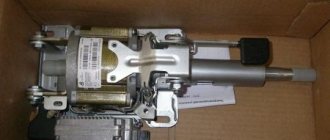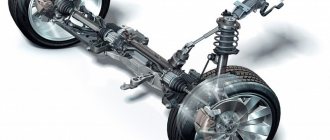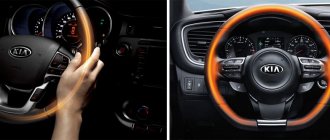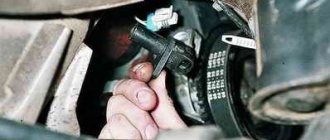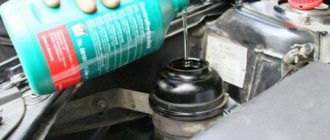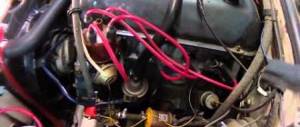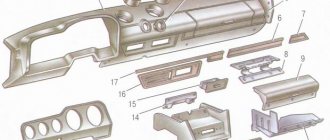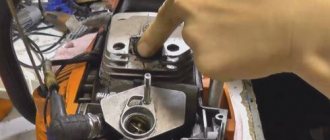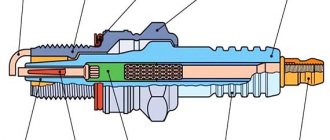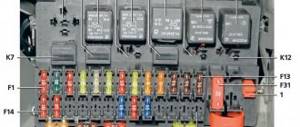Electric power steering - main advantages
When operating an electric amplifier, energy costs are slightly lower, because it is switched on only when it is needed. And the hydraulic pump constantly pumps liquid. Actually, due to lower energy consumption, such a steering drive allows reducing fuel consumption (on average by 200 grams per hundred kilometers).
Composition of an electrically driven amplifier:
1 — steering wheel, 2— steering column, 3— propeller shaft, 4— electric motor, 5— steering mechanism, 6— control unit, 7— torque sensor
What is electric power steering
The electric booster is a high-tech unit that eliminates hydraulics and operates entirely electronically. If we compare hydraulics and electronics, the latter is rapidly gaining popularity among both drivers and manufacturers. The main advantage is the cost of production, which is an order of magnitude less than a hydraulic one, and also requires virtually no attention.
Most of the control comes from sensors and electronics that monitor the driver's actions, analyze the data received, and transmit signals to actuators to turn the wheels. Among the frequent breakdowns, they are most likely in the nature of a defect, flaws in control, wear of parts, etc. Meanwhile, the manufacturer takes into account all sorts of shortcomings and, to the extent possible, eliminates them. If we talk in general about quality and comfort, then the main plus is the absence of vibration and shock transmission to the steering wheel.
MECHANISM DEVICE
The EUR can have a device with different layout options:
- The mechanism contains a steering rack that absorbs the force.
- The electric motor transmits force to the steering shaft.
Most often in cars, an EUR with a rack is used. There is a design of a mechanism with a parallel drive, in which there are two gears. The classic rack and pinion design includes an electric motor, a mechanical transmission and an on-board computer that controls it all. The device technically combines the mechanical part with the electrical part in a single unit. The operating principle of electric power steering is based on the operation of an asynchronous electric motor.
Operating principle of electric power steering
As already mentioned, the electric booster does not always work; it comes into operation only when the driver turns the steering wheel. The power steering motor produces a torque that depends on the torque on the steering gear. This torque is measured by a torque sensor, which transmits data to the amplifier control unit.
The control unit also calculates the required power to turn on the amplifier motor depending on the angle of rotation of the steering wheel. The steering angle is measured by a sensor that is built into the steering column switch. A sensor is also installed on the rotor of the engine itself, measuring its rotation speed to receive feedback to the control unit. That is, so that the unit “sees” whether the electric booster motor is spinning at the required speed, and whether there is an erroneously slow or too fast rotation.
The force from the amplifier motor is transmitted to the rack through the drive gear and worm gear. The rack moves using two forces: directly from the steering wheel, driven by the driver, and from the amplifier motor, controlled by the control unit.
Advantages of electric steering over power steering and electric power steering
Drivers of cars equipped with hydraulic and electric power steering are forced to put up with their many disadvantages, namely:
- You can keep the wheels in the extreme position for no more than five seconds, otherwise the oil in the system will overheat and the power steering will fail;
- the need for periodic maintenance (you need to monitor the oil level, change it, monitor the condition of the drives, hoses and pump);.
- Power steering operation consumes part of the vehicle engine power;
- the device operates in one mode, regardless of driving conditions;.
- reduction in the information content of the steering wheel at high speeds (this drawback is partially eliminated through the use of a steering rack with a variable gear ratio).
The advantages of electric power steering are reliability, efficiency and compactness. Its operating principle is based on the operation of an electric motor, so the device is much simpler. The electric power steering is not driven by the car's power unit, and also works only when the steering wheel is used, thanks to which it saves from 0.4 to 0.8 liters of fuel, depending on driving style and road conditions. Electric power steering does not require maintenance, however, in the event of a breakdown, the faulty components are replaced entirely, so the cost of repairs increases significantly. Perhaps the most important advantage of electric power steering is the ability to change the auxiliary force depending on the driving conditions of the vehicle, thereby achieving sharper control at high speeds and easier control at low speeds. In addition, the same model can be used on different machines, and all that is required is to change the settings of the electronic control unit.
Parking mode
The torque sensor transmits information about the presence of large torque on the steering wheel. The block also receives data on the steering angle. And if the turning angle and torque are large, and the car’s speed tends to zero, then the control unit determines this as a parking mode and gives a command to maximize the steering movement. In this case, the crankshaft rotation speed must be taken into account.
Thus, at zero speed and active steering, the maximum gain from the electric motor acts on the rack.
Operating modes
EUR is a device whose operation varies depending on the current mode. During parking, when the car is immobilized or the speed is minimal, the servomotor works with maximum efficiency, activating the “light steering” function. The principle is as follows:
- The torque sensor transmits data on sudden turns of the steering wheel;
- The control unit contains information about the angle of rotation;
- After analyzing the data and driving speed, the control unit turns on the parking mode and speeds up the engine.
City mode (speed up to 50 km/h). The peculiarity of driving around the city is the need to constantly turn the steering wheel in one direction or another. The algorithm for operating the EUR is as follows:
- Data on the steering angle and speed are sent to the control unit;
- The “brains” of the device give a command about the need to achieve average power of rotation of the steering wheel;
- At speeds of 100 kilometers per hour, when better controllability is needed, the steering wheel becomes “hard” (“heavy”). It turns out that when high speeds are reached, the power steering almost does not work.
Cars with ESD provide the following functions:
Mode of active return of wheels to their original position.
When the load on the steering wheel decreases while driving, the torsion bar unwinds. The control unit sees this information and calculates the speed at which the wheels return to their original position. The resulting value is compared with the current parameter, after which the required force is generated to return the wheels.
As a rule, during a turn, additional forces appear in motion, “pushing” the wheel into a neutral position. But the presence of friction force does not allow this to be realized. The task of the control unit is to make the necessary calculations and help the wheels return to their starting position.
Average position correction mode.
This mode is activated when driving in a straight line. In unfavorable weather conditions (strong wind from the side) or with different tire pressures, the control unit regulates the force and improves the car's handling. There are two options here:
- Long-term correction is relevant when the problem is long-term (for example, tires have different pressures);
- Short-term correction—triggered in case of temporary problems, for example, increased crosswind.
Active return of wheels to the center position
When the driver reduces the steering force while cornering, the torsion bar unwinds. The control unit, based on sensor readings, sees this and calculates the speed at which the wheels return to the center position depending on the magnitude of the drop in torque on the steering wheel, as well as on the angle and speed of rotation of the steering wheel. This calculated value is compared with the actual return force and the result of the comparison serves as the basis for determining the torque required to return the wheels to the center position.
Usually, when turning wheels in motion, reactive forces arise that tend to return the wheel to the middle position. But due to friction forces in the steering mechanism and suspension, they are not able to independently return the wheels to their original position.
The control unit takes into account all the necessary data and ensures that the steered wheels return to the center position using the amplifier motor.
Description of the EUR
The design of the
EUR device uses a small electric motor. It creates additional force on the steering shaft when turning. Thanks to this, it was possible to reduce the size of steering wheels in cars. Truck drivers were the first to appreciate this new product; today it is available on almost any passenger car.
The system itself consists of several main elements:
- brushless electric motor;
- steering angle sensors;
- torque;
- control unit;
- servo.
They are the main elements that make up the electric power steering. But the design itself is somewhat broader and will be discussed below, immediately after the functions, as well as the pros and cons of the system.
Features, Pros and Cons
Installing the device in a VAZ 2110
A competitor to this system is the hydraulic booster and electric hydraulic booster. The difference between the ESD and the power steering: if the ESD breaks, nothing bad will happen, but if the power steering breaks down, you need to remove the belt, and in some cars this is impossible to do. But if you drive without oil, the pump will have to be replaced.
Power steering and electric steering have obvious disadvantages. So, you cannot keep the wheels in the extreme position for more than 5 seconds, otherwise it will overheat. It also requires periodic maintenance. Well, and finally, at high speeds, the information content of the steering wheel decreases.
But the electromechanical amplifier, also known as EUR and EMUR, has the following advantages:
- reliability;
- efficiency;
- compactness;
- change in force depending on driving conditions.
The main disadvantage is that it is practically impossible to replace individual components. If they fail completely, you will have to replace the entire system, and this is quite expensive.
As for the functions, it is essentially the same - to make driving easier by taking on part of the required effort. With such a device, the car becomes much more obedient even in difficult conditions. You will learn more about the device in the video below (the author of the video is Car Sales CAR SHOWROOM First Video AutoMarket).
Design and operating principle
On different types of cars, the electric power steering can be installed in different places.
So, on small cars that do not require particularly strong impact, the system is installed directly in the steering column. The device is located directly in the cabin under the control wheel, where all the sensors are located. This position protects the electric power steering from dirt and other influences.
On middle-class cars, the system is located on the steering rack. The force is transmitted through the gear. This system is somewhat less reliable, but widespread.
SUVs and minibuses require installation of the system on a parallel-axle structure. In this case, force is transmitted from the electric motor using a toothed belt drive, as well as a mechanism of a screw and nut on circulating balls. In this case, the nut rotates with a belt, which transmits the force to the balls, from which it passes to the steering rack.
The basic principle of operation of electric power steering is the transfer of additional influence in order to facilitate vehicle control.
1. Device for small machines
2. Design for middle class cars
3. Design on buses and SUVs
Correction of the center position of the wheels (steering)
This is straight line driving mode. It’s just that sometimes third-party forces, such as side winds, can act on the car. Usually, in this case, the driver has to independently keep the car on the correct course. In the case of an electric amplifier, this is not necessary; the amplifier control unit will do everything itself.
Long-term correction
The amplifier operates in long-term correction mode when it is necessary to constantly correct the vehicle’s deviation from a straight course, for example, with unevenly worn tires.
Short-term correction
In the case of a crosswind, its gusts are inconsistent, so the amplifier operates in short-term steering mode. This steering occurs without driver participation. Thus, electric power steering increases the comfort of driving.
Related video:
Principle of operation
Regardless of the design features of the electric booster, the principle of operation (EUR) is as follows: When the car is moving at low speed (in a traffic jam, in the yard, in the parking lot), the driver has to quickly turn the wheels from one extreme position to another. In this case, the electric power steering is provided by the so-called “light steering”. You can easily rotate the steering wheel with one finger. When you drive at high speed, you rotate the steering wheel at small angles.
In this case, the electric power steering creates feedback (more details in the power steering), and the steering wheel turns out to be heavy. Electric power steering also creates feedback and is able to return the wheels to the center position (when you enter a turn, and at the exit the steering wheel automatically returns to the center position).
In the electronic control unit of the electric power steering, there are also programs for stabilization, maintaining the average position of the wheels during strong gusts of side winds, at different tire pressures, as well as a parking assistant (parking assistant).
The parking attendant steers and automatically directs the car to the desired, free parking space. The driver can only press the accelerator, clutch and brake pedals.
